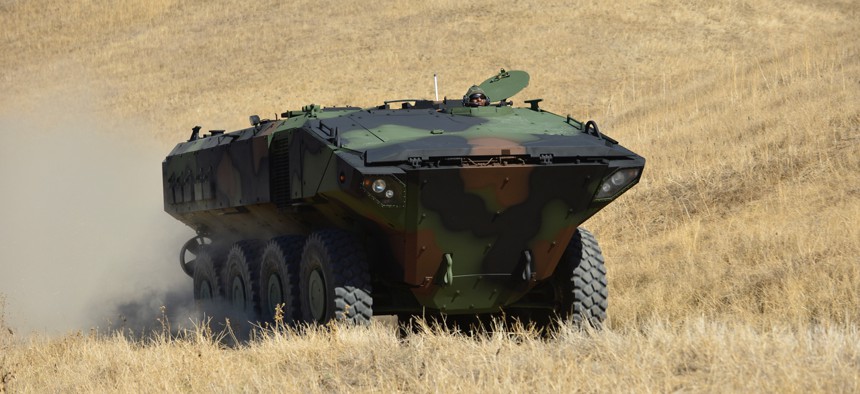
The Marine Corps has chosen the Iveco SuperAV in the Amphibious Combat Vehicle competition. BAE Systems
Marines to Buy New Amphibious Combat Vehicle from BAE Systems
The armored personnel carrier will replace the four-decade-old Amphibious Assault Vehicle.
The U.S. Marine Corps has chosen BAE Systems to build new Amphibious Combat Vehicles, kicking off the long-awaited replacement of the four-decade-old armored personnel carriers that currently carry Marines from ship to shore.
BAE’s eight-wheeled vehicle beat out a similar one pitched by SAIC. The contract awarded Tuesday orders 30 ACVs for a total of $198 million, with deliveries starting late next year. Follow-on contracts are expected to total 204 ACVs for more than $1 billion. The plan then calls for buying 400 copies of a more advanced and capable variant of the ACV, allowing the Corps to retire the AAV in the mid to late 2020s.
The Marines found the BAE proposal a better value, John Garner, program executive officer for Marine Corps Land Systems, said on a conference call Tuesday.
The ACV will “bring a modern, wheeled capability that has landward mobility on par with a modern battle tank along with the remarkable survivability that the system has for underbody blast and then also other threats,” Col. Wendell Leimbach, the Advanced Amphibious Assault program manager, said on the call. “We were able to demonstrate that and prove to ourselves that as we move forward we truly have a game-changing capability in the ACV that will allow the Marine Corps to operate across all of its mission profile, including that extremely challenging littoral region that includes the surf and the open ocean.”
Jerry DeMuro, the president and CEO of BAE Systems, called the effort a model program that has largely remained on schedule.
“They have hit every single milestone and have really moved that thing apace,” he said Tuesday morning — before the contract was announced — at the Defense One Global Business Briefing.
DeMuro attributed the project’s discipline to the “leadership focus within the Corps all the way up to the commandant.”
The Amphibious Combat Vehicle project is the Marines’ latest attempt to replace its fleet of 870 Amphibious Assault Vehicles that debuted in 1972. The Corps spent $3 billion to develop the more complex Expeditionary Fighting Vehicle before cancelling the program in 2011.
The Marines took another crack in 2014 with a scaled-down, more incremental approach to developing an amphibious vehicle. A year later, it purchased Amphibious Combat Vehicle prototypes from BAE and SAIC. BAE offered the Iveco SuperAV vehicle while SAIC and teammate ST Engineering Land Systems offered the TERREX vehicle.
“We are well positioned and ready to build the future of amphibious fighting vehicles for the Marine Corps, having already produced 16 prototypes,” Dean Medland, vice president and general manager of Combat Vehicles Amphibious and International at BAE Systems, said in a statement. “Through this award, we are proud to continue our partnership with the Marine Corps by providing a best-in-class vehicle to support its mission through mobility, survivability and lethality.”
SAIC said it was disappointed its vehicle was not selected.
“We believe that our vehicle ... provided the Marine Corps with an innovative solution at best value to meet current and future requirements,” the company said in a statement. “We are extremely proud of our performance during the Engineering & Manufacturing Development phase and we will build upon this progress in our growing platform integration business.”
The company said it would “continue to focus on production of the Assault Amphibious Vehicle Survivability Upgrade for the Marine Corps and our ongoing efforts in combat and tactical vehicle modernization. We are committed to growing this line of business, in alignment with the defense department's focus on readiness and modernization, and we are excited about our future.”
Both vehicles were evaluated during combat-like drills at Twentynine Palms and Camp Pendleton in California.
“By and large, the design is proven to be extremely reliable and robust,” Leimbach said of the BAE vehicle.
The first Amphibious Combat Vehicles will be assigned to the 3rd Assault Amphibian Battalion at Camp Pendleton.




